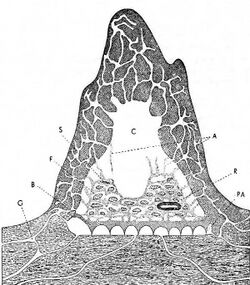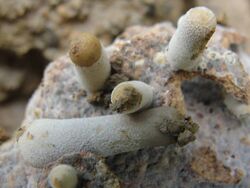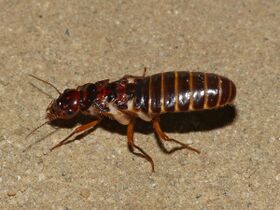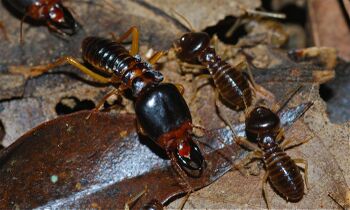Biology:Macrotermes
| Macrotermes | |
|---|---|

| |
| Structure of an M. natalensis mound | |
| Scientific classification | |
| Domain: | Eukaryota |
| Kingdom: | Animalia |
| Phylum: | Arthropoda |
| Class: | Insecta |
| Order: | Blattodea |
| Infraorder: | Isoptera |
| Family: | Termitidae |
| Subfamily: | Macrotermitinae |
| Genus: | Macrotermes |
| Species | |
|
See text | |
Macrotermes is a genus of termites belonging to the subfamily Macrotermitinae and widely distributed throughout Africa and South-East Asia. Well-studied species include Macrotermes natalensis[1] and M. bellicosus.
Like other genera in the Macrotermitinae, they consume dead plant material indirectly by cultivating a basidiomycete fungus of the genus Termitomyces on galleries inside – often very large – termite mounds. Frequently at the beginning of the rainy season, enormous swarms of winged flying adults disperse to establish new colonies.
Spores are sown on the wood in the nest and treated with a growth hormone. The termites feed on the resulting fungus garden.[2] The fungi produce heat in the nest, which rises towards the closed chimney. The heat is exchanged via the chimney, and its smaller tunnels that lead to the surface. Carbon dioxide and oxygen are exchanged near the surface of the nest, and workers may open or block individual tunnels to regulate temperature.
Life cycle

Shortly after a nuptial flight, the fully claustral male and female pairs set off to immediately find a safe location to found a new colony, and unlike their xylophagous relatives, instead sequester themselves within the native sand-clay soils of their habitat. The eggs can take anywhere between 15 and 30 days to hatch into several dozen nymphs, which later differentiate and mature into the first workers and soldiers.
Similarly to Attini fungus-growing ants, the life cycle of these termites is intimately tied to that of their symbiote. Macrotermes like the majority of Macrotermitinae primarily practice the horizontal mode of transmission of their obligate symbiotic fungi, with the sole exception of Macrotermes bellicosus which practices vertical transmission of their symbiote; i.e., the reproductives carry fungus material within their crop to start new fungus gardens, as opposed to the mode of horizontal transmission where the spores of their Termitomyces symbiote must be foraged for in the environment.
A couple months after nuptial flights, mature colonies of species that practice the horizontal mode of transmission have mushrooms erupt from the surface of their nests. These mushrooms release spores into the environment which is timed to when the first workers of young colonies have begun foraging. Workers pick up these spores while foraging and ingest the spores incidentally while consuming detritus consisting of dead woods, grasses and leaves at varying stages of decomposition. The guts of the termites work to act as sterilization stations so that nothing but the Termitomyces spores survive. The spores are later defecated along with the partially digested lignocellulose material which is molded into the primordial fungus comb; a brown pillar-like structure. The spores germinate soon after and grow to cover the primordial comb, appearing as a smooth layer of silky white, tightly interwoven mycelium. As it digests the cellulose and matures, the fungus grows white nodules on the surface of the comb – which is what the termites eat directly. As the fungus exhausts the substrate in the comb, new substrate is added and the old substrate is then also eaten by the termites.

Relationship with humans
Macrotermes termites are economically important pests that damage crop plants, rangelands, wooden structures and books. They may cause yield losses of up to 100%.[citation needed]
One study of wooden utility poles in Nigeria found that over two-thirds were infested by M. bellicosus. The termites visibly eroded the poles' base and structural strength, causing 53% of infested poles to tilt.[3]
Some species of Macrotermes are eaten by humans in Africa. Alates are eaten the most, but workers and soldiers are also eaten and they are available throughout the year, unlike alates. One method of gathering them is to pour water over dry termite mounds in winter, mimicking the spring rains when termites are more active. In the South Africa n province of Limpopo, Macrotermes soldiers and workers often occur in yards in rural areas, and on sidewalks in towns.[4]
In Kenya, Macrotermes alates are sold commercially for retail prices comparable to that of goat meat. Trade of termites is dominated by women and involves collectors who sell to wholesalers, who then sell to retailers. The termites are typically preserved by drying, less commonly by frying. They are ground into flour for use in baking.[5]
Species
The following species are included in the Termite catalogue:[6][7]
Gallery
-
alate
-
de-alate
-
soldier and workers
-
workers
References
- ↑ "Complementary symbiont contributions to plant decomposition in a fungus-farming termite". Proceedings of the National Academy of Sciences of the United States of America 111 (40): 14500–14505. October 2014. doi:10.1073/pnas.1319718111. PMID 25246537. Bibcode: 2014PNAS..11114500P.
- ↑ Insektopedie. Cape Town: Struik Nature. 2017. pp. 114–116. ISBN 978-1-77584-198-2.
- ↑ "Preliminary Survey of Macrotermes Bellicosus Infestation on Public Utility Poles in Ekosodin Community, Nigeria; Implication for Uninterrupted Electricity Supply". African Journal of Health, Safety and Environment 3 (1): 224–232. 2022-04-01. doi:10.52417/ajhse.v3i1.207. ISSN 2695-1819. https://www.ajhse.org/index.php/ajhse/article/view/207.
- ↑ "Overview of the Genetic Diversity of African Macrotermes (Termitidae: Macrotermitinae) and Implications for Taxonomy, Ecology and Food Science". Insects 12 (6): 518. June 2021. doi:10.3390/insects12060518. PMID 34204854.
- ↑ "Commercialization of Alate termites (Macrotermes sp.) to improve households' livelihoods in Vihiga county, Kenya". African Journal of Food, Agriculture, Nutrition and Development 22 (106): 19326–19338. 2022-02-27. doi:10.18697/ajfand.106.21085. https://ajfand.net/Volume22/No1/Anyuor21085.pdf.
- ↑ "Termes (Macrotermes) Holmgren 1909: 193". Termite catalogue. Termite Laboratory - University of Brasília. http://164.41.140.9/catal/gen_names.php?cod_gen=52.
- ↑ "Macrotermes". Index to Organism Names. http://www.organismnames.com/query.htm?q=Macrotermes&searchType=simple&so=a0ION.
- ↑ "Husbandry and breeding of African Giant Termites (Macrotermes jeanneli) at Berne Animal Park". Zoologische Garten 74 (1): 26–37. 2004. http://www.tierpark-bern.ch/pdf/Publikation_termiten.pdf.
Wikidata ☰ Q14640326 entry
 |




